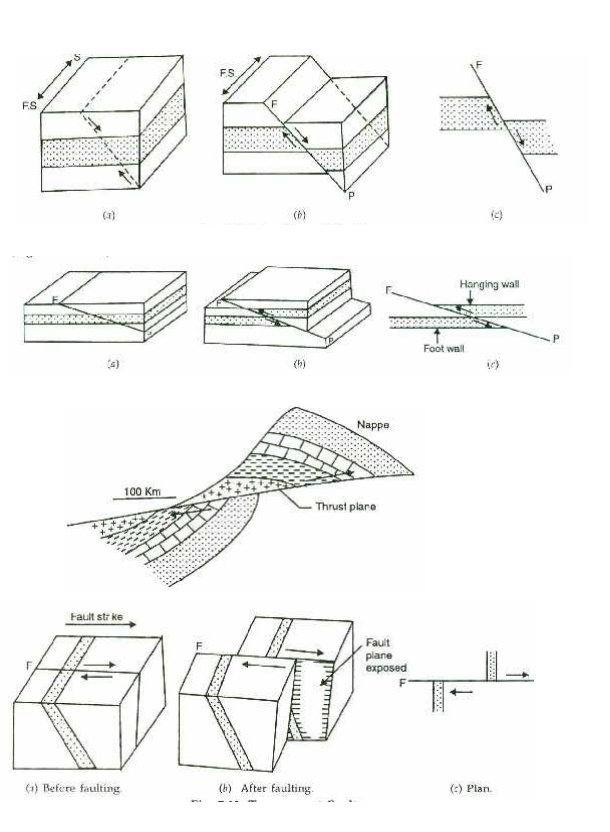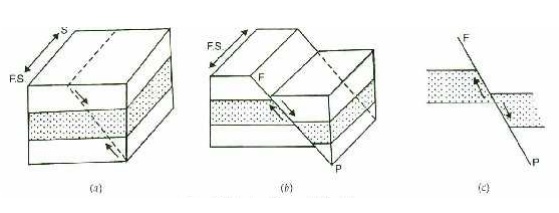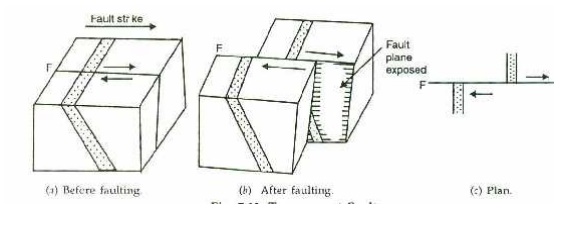Chapter: Civil : Engineering Geology : Structural Geology And Geophysical Method
Structural Geology: Fault And Faulting

FAULT And FAULTING
Ø Those
fractures along which there has been relative movement of the blocks past each
are termed as FAULTS.
Ø The
entire process of development of fractures and displacement the blocks against
each other is termed as
FAULTING CLASSIFICATION OF FAULTS
Following factors are more commonly considered
important in classification of faults: The apparent movement of the disrupted
blocks along the fault plane;
The
direction of slip;
The
relation of fault attitude with the attitude of the displaced beds; The amount
of dip of the fault;
Mode of
Occurrence.
Three fundamental types of faults
are commonly distinguished on the basis of apparent movement: normal faults,
reverse faults and strike slip faults.
Normal Faults
Ø Such a
fault in which hanging wall has apparently moved down with respect to footwall
is classified as a Normal Fault.
Ø In this
definition it is clearly implied that nothing can be said with certainty
whether it was the hanging wall which moved down or the foot wall which moved
up or both the walls moved down, the hanging wall moving more than the foot
wall and hence the appearance.
Ø when the
fault satisfies the definition of hanging wall standing at a lower position
with respect to the footwall it may be classed as a normal fault.
Ø In normal
faults, the fault plane may be inclined at any angle between horizontal and
vertical, but most commonly, the fault angles are between 45 and vertical.
Ø further,
due to the inclined nature of the fault plane and downward displacement of a
part of the strata, normal faults cause an extension in the crust wherever they
occur.

Reverse Faults
Ø It is
such a type of fault in which the hanging wall appears to have moved up with respect
to the footwall.
Ø In
reverse faults, the fault plane is generally inclined between horizontal and 45
degrees although reverse faults with steeply inclined fault surface have been
also encountered.

By virtue of their inclination
and direction of movement, reverse faulting involves shortening of the crust of
the Earth (compare with normal faults).
Thrust
Faults
Ø These
are, broadly speaking, such varieties of reverse faults in which the hanging
wall has moved up relative to the footwall and the faults dip at angles below
45 degrees.
Ø The
thrust faults or simply thrusts are of very common occurrence in folded
mountains and seem to have originated as a further step in the process of
adjustment of rocks to the imposed stresses.
Ø Thrusts
are sometimes further distinguished into two sub-types: the over thrusts and
the under thrusts.
Nappes
Ø This term
is used for extensive blocks of rocks that have been translated to great
distances, often ranging to several hundred kilometers, along a thrust plane.
Ø The
large-scale movement maybe attributed to a major over thrusting or a recumbent
folding followed by thrust faulting.

When a series of thrust faults
occur in close proximity, thrust blocks are piled up one above another and all
fault surfaces dip in the same direction, the resulting interesting structure
is known as an imbricate Structure.
Strike-Slip Faults
Ø These may
be defined as faults in which faulted blocks have been moved against each other
in an essentially horizontal direction.
Ø The fault
plane is almost vertical and the net slip may be measured in great distances.
Ø There are
some other terms used for strike slip faults such as lateral faults, transverse
faults, wrench faults and transform faults.
Ø Of these,
the transform faults are very common and denote strike slip faults specially
developed in oceanic ridges.

ENGINEERING
CONSIDERATIONS
Ø The
safety of a civil engineering structure built on or near a faulted rock can be
ascertained only in a general way.
Ø The
tectonic history of the area under consideration must be known (or studied if
not known) thoroughly.
Ø Faults of
any significance are always associated with earthquakes.
Ø So, such
a study would virtually mean obtaining information about frequency of the
earthquakes as also their magnitude and effects that they have left from time
to time on the rocks of the region.
Ø The exact
position of the area of construction with respect to the seismic zoning of the
country must be thoroughly established.
Ø Even if
the evidence collected from the study of the tectonic history of the area leads
to the conclusion that no movement may be expected in the rocks of the area
during the projected life span of the structure raised on them, some factor of
safety must be introduced into the design of the structure, especially in the
big projects in faulted areas, so that if the unexpected happens, there is
minimum loss to the project.
Ø In all
big countries, maps of seismic classification are available.
Ø In most
cases recommendations of the statutory authorities are available about introducing
suitable factor of safety in major civil engineering projects of any public
importance that are proposed to be constructed in areas of known seismic zones.
Related Topics